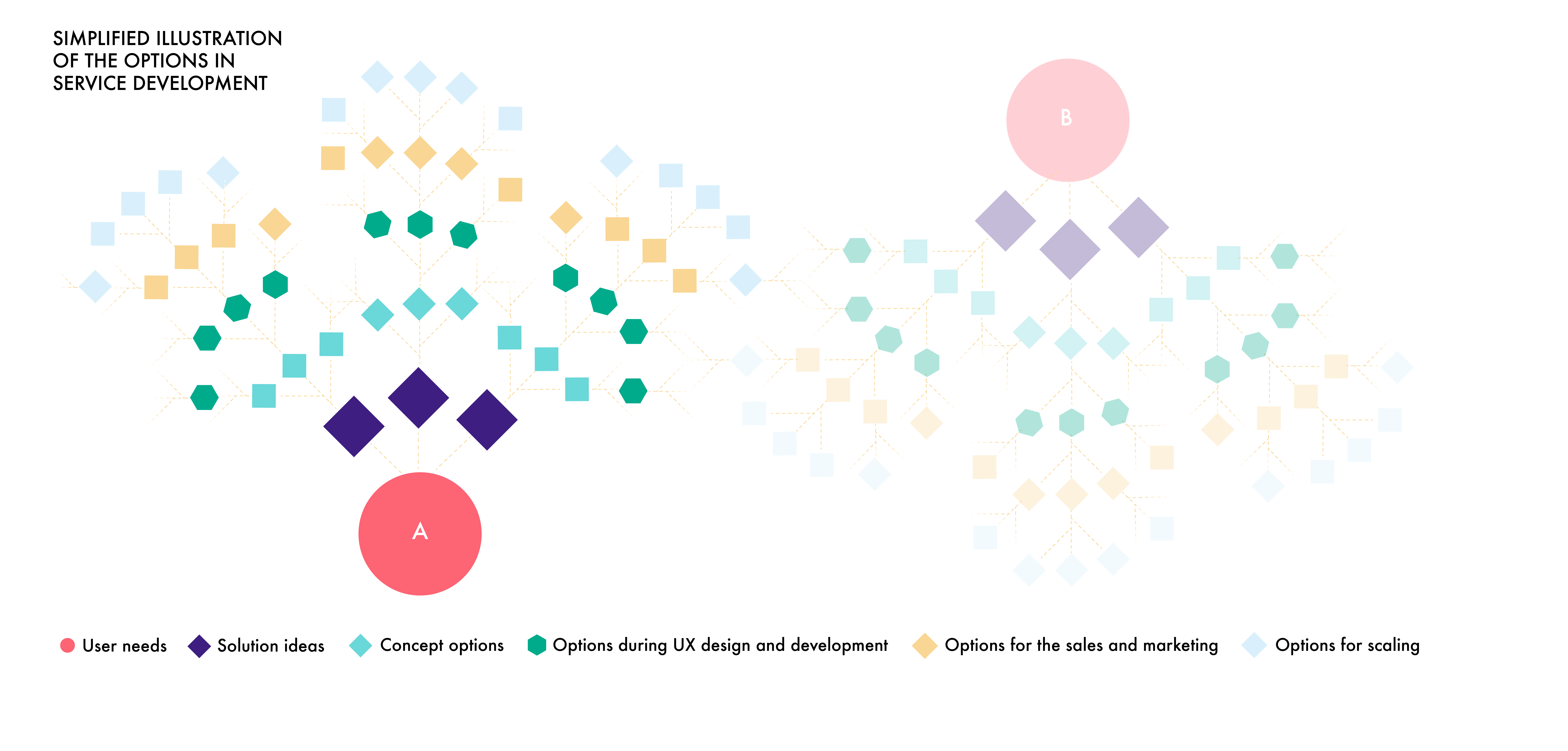How to guide development work by involving potential users and so reduce financial risks
Investment risks in building something new can be lowered by utilising user insights at all major decision points. The probability of the service actually fulfilling the need of buyers and end-users in the most appropriate way is higher when they are involved throughout the development process. This increases the likelihood of making the right decisions for reaching business targets.
This article describes some key steps along the way to launching a new digital service. However, these phases could apply to other types of service development, too.
The graph below illustrates the decision points along the way where involving actual end-users helps focus development efforts and increase the probability of reaching the target return-on-investment. Compared to the actual building of the service, user research is inexpensive and user insights deliver significant value by helping the team focus their efforts in the right area.

The stages: Why and when you should involve the end-users in service development:
1. The what: The most important customer needs or problems to respond to, considering the needs of the business as well as users.
2. The how: In what way and in which channel(s) should this ‘need’ be satisfied.
3. The concept: Prioritising the core of the service and other features required to create a feasible and desirable solution for a sufficiently large user group in order to generate viable business.
4. The usability: Making sure the service is understandable to use and utilising user insight in decision points and for prioritising work.
5. The sale: How and where to communicate to the potential users about the service.
6. The scale: Collecting usage data, understanding the problems within the service and growing the product to suit more use cases, for more frequent use and for new user groups.
Stage 1: ‘The What’
Identifying the needs and problems worth solving
It’s a common misconception that user research is only done at the beginning of the project where latent needs or user problems are discovered and initial hypotheses are validated. The truth is it’s important to do it throughout the process of creating the service, but different phases place different demands on how to use the gained insights and deal with identified problems or needs.
Prioritisation is important at every juncture. Solving some user needs might bring significant value to some user group but the solution itself does not bring additional value to the business – and other solutions might be valuable for both, but the user group served just isn’t large enough to create a viable business.
Discoveries from the research are always exciting, but it is important to critically review the gathered data. A project team with personal experiences in one need and not with another runs the risk of reaching biased conclusions if the data is not carefully reviewed. Or someone from higher management might fall in love with one idea and ends up highlighting research findings that back up that idea over others.
So stop and take the time to critically review the work done. Is our team biased and trying to find data that backs up our favourite idea? Or are we trying to make a business out of solving a need that just isn’t critical or frequent enough? Should we dig deeper into some topic or user group that seems interesting or try to get some quantitative data? Doing customer interviews is not hard, but it is possible to do it poorly if you rush into it without properly considering how best to scrape together the most interesting information for service development.
At the early stages of development, service design blends beautifully with business skills: entrepreneurship, strategic work, market and industry analysis and understanding of business models.
Steps for figuring out ‘The what’
- Interview 10-15 potential users with open-ended questions about their experiences, behaviour, process, needs and attitudes in relation to the subject matter.
Analyse the data is during the interview process so that recurring interesting phenomena can be further discussed and the already gathered insight can be validated in further interviews. After the interviews, you’ll have enough data to create behavioural user archetypes and identify the needs business could solve.
Prioritise insight based on business needs. Add quantitative data collected via a survey, for example, into the mix. The project team should ask questions like: What challenges do we have the willingness and capability to tackle? What is the domain with the least competition? Prioritisation should be done with key business stakeholders and experts of this domain.
Ideate solutions to the selected problems. There are usually multiple ways to solve each problem, so there will be a lot of ideas! One idea can also solve many needs and problems that were identified, there’s no need to forget any insight after it has been prioritized!

Stage 2: ‘The how’
Stage 2 is also very important because it is possible to solve a burning user need but you may end up doing it in the wrong channel for example and as a result users never get to it or they might find it cumbersome. The more impactful an interaction will be on the user’s life the more information and personalised support the customer wants. It is possible that the user interface and flow of a service is very pleasant to use, but the users don’t feel like they are knowledgeable enough to complete the interaction solely as a self-service or without more guidance available online. This kind of scenario can happen for example in the financial sector.
Steps for figuring out the ‘the how’
Prioritise and further develop ideas with users, while still welcoming new ideas which can then be validated in the next round of interviews.
Get the relevant business and feasibility stakeholders together to prioritise the ideas from the business perspective. The more hard and soft data you have available, the better the results from this meeting will be.
Stage 3: ‘The concept’
The next stage is about creating the outlines of the concept. One concept can include multiple ideas and solve several user needs. Skipping stage 3 can have a negative impact by steering towards building a service that seemed viable during the development stage, but just doesn’t succeed after launch.
You might have a budget allocated for UX testing before launch, but not for validating which features are worth developing in the first place. If validation isn’t done early enough, you may end up wasting your efforts on trivial features, while more important features are left out. This will have a significant impact on how appealing users find the service and, ultimately, how successful it will be. The service may also end up being cumbersome to use or too expensive due to too many features. Or it may have too little to offer to attract enough users: solving just one need may not be enough to spark continuous use.
Taking a calculated risk to learn via the market by launching quickly is one way forward, but testing idea mockups with real potential users will significantly increase the likelihood of building the kind of service users want. Odds are you’ll get it out just as fast.
Steps for figuring out the ‘the concept’
Start developing the selected idea with users. Can the solution be purely self-service, and if not which parts can and can’t be? Which features are the most important and what feature set is sufficient? What different needs do the different user profiles have and do we decide that some of them are not our target audience?
Define the concept. Use the visualisations produced for user testing. Define your minimum viable product and create a development roadmap.
Stage 4: Nailing ‘The usability’
Every service creation process has phases where there are multiple different options for implementing specific features. If the decisions are made without utilising some form of user insight, the result might not fulfil user needs as intended. This is where service design comes close to product ownership or user experience design.
User experience (UX) and user interface (UI) are validated to ensure that the service is easy to use. If the UX is not validated, customers may not find what they need, can’t use all of the functionalities or might end up spending too much time to complete a task. This will steer them towards choosing a competing option with better user experience.
Stage 5: Finding how to close ‘The sale’
This is where service design comes closest to marketing. The original user insight can be utilised for planning communications to different user profiles. This can mean sales personnel asking a couple of questions in order to tailor their pitch or offering customised content with a different message per user profile, in different channels.
Stage 6: ‘The scale’
It’s always a good idea to collect data on the usage of the service and pair this data with surveys and interviews to find out the reasons for behaviour evident in the data. Improve conversions by creating different versions of the service and measuring which works best. Collect user profile data to find out who the service currently serves well and where the growth opportunities are. A clear plan and tools for how to utilise and answer feedback from customers should be in place before launch. You will probably have lots of ideas for new features gathered from previous research and incoming feedback. Use little experiments and campaigns to see how they resonate with customers and which ones should be developed further. It is also possible to test different marketing messages and tailored content to attract users to the service. Here service design starts to blend with growth hacking.
Conclusion
To maximise your chances of launching a successful service, validations with potential users should be done throughout the development process. What and how is researched or validated, and who is involved in the project team just varies according to phase. You can start a service design or user research project from any of these phases.
 Laura AhoSenior Service Designer
Laura AhoSenior Service Designer


